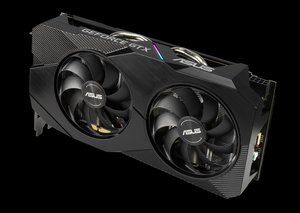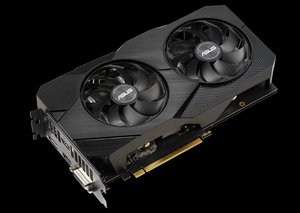Asus Boosts GTX 1660 Ti Lineup With New Evo Series Graphics Cards
When the Nvidia GeForce GTX 1660 Ti first came out, Asus released four different versions of the graphics card with the familiar ROG Strix, TUF Gaming, Phoenix and Dual branding. The three new Asus Dual GeForce GTX 1660 Ti Evo graphics cards unveiled this week feature a different cooling mechanism, as well as the Axial-tech fan design found in their high-end ROG video cards. The Axial-tech fans use longer blades and a barrier ring said to increase downward air pressure while improving cooling and lowering noise levels.


The fans push air through a newly designed heatsink that is “2.7” slots wide to increase the surface area for lower fan speeds at light loads and increased overclocking potential, via more thermal headroom. The black plastic shroud on the heatsink includes one RGB LED illumination element, a single line on the top of the card located on top of the card where the heat pipes stick out. The implementation looks tasteful for those who may not like the disco light show many of today's cards cast. Last, the PCB uses an aluminum back plate to add rigidity, as well as a physical barrier to protect the back of the cards.
The Axial-tech fans use a smaller hub to make room for the longer blades. There's also a ring around the outside connecting the edges of the fan blades, which Asus says increases air pressure. If noise is a concern, particularly while at the desktop or light loads, the cards all feature 0dB technology, which disables the fans when the graphics card's temperature is under 55 degrees Celsius.
The new Dual Evo Series is hitting the scene in three flavors. The base model is clocked at 1,500 / 1,770 MHz (base / boost clocks, respectively), the Asus Dual GeForce GTX 1660 Ti EVO Advanced Edition is clocked at 1,500 / 1,785 MHz and the fastest of the three, the Asus Dual GeForce GTX 1660 Ti EVO OC Edition, runs at 1500/1845 MHz. Memory speeds on all three cards come in at 12,002 MHz. If the stock clocks are not enough, all three cards offer an overclock mode with slightly increased core speeds. A single 8-pin PCIe connector feeds the cards power.
All Dual GTX 1660 Ti Evo cards use a single DisplayPort, two HDMI ports and a DVI-D connector for outputs to your monitor. The I/O plate has large holes to help exhaust air out of your PC case.
Neither pricing nor availability was listed. However, we expect pricing to small somewhere between that of the ROG Strix and Dual GTX 1660 Ti series' pricing.
Photo Credit: Asus
Get Tom's Hardware's best news and in-depth reviews, straight to your inbox.

Joe Shields is a staff writer at Tom’s Hardware. He reviews motherboards and PC components.
